Research
Organic Materials for Molecular Electronics
Research activities of our group are focused on exploring the manifold of molecular electronics ranging from organic photovoltaics, light-emitting diodes and field-effect transistors. Our interdisciplinary approach includes synthesizing multifunctional conjugated polymers and oligomers with novel properties and studying their characteristics working at the interface of chemistry, physics and materials engineering. We take advantage of molecular structures to fine tune the desired properties through molecular design and robust synthetic strategies.
The group at present is actively engaged in developing organic materials for-
- Organic Solar Cells
- Organic Field-Effect Transistors
- Thermally Activated Delayed Fluorescence (TADF)
- Singlet Fission
- Electrochemical Energy Storage Device
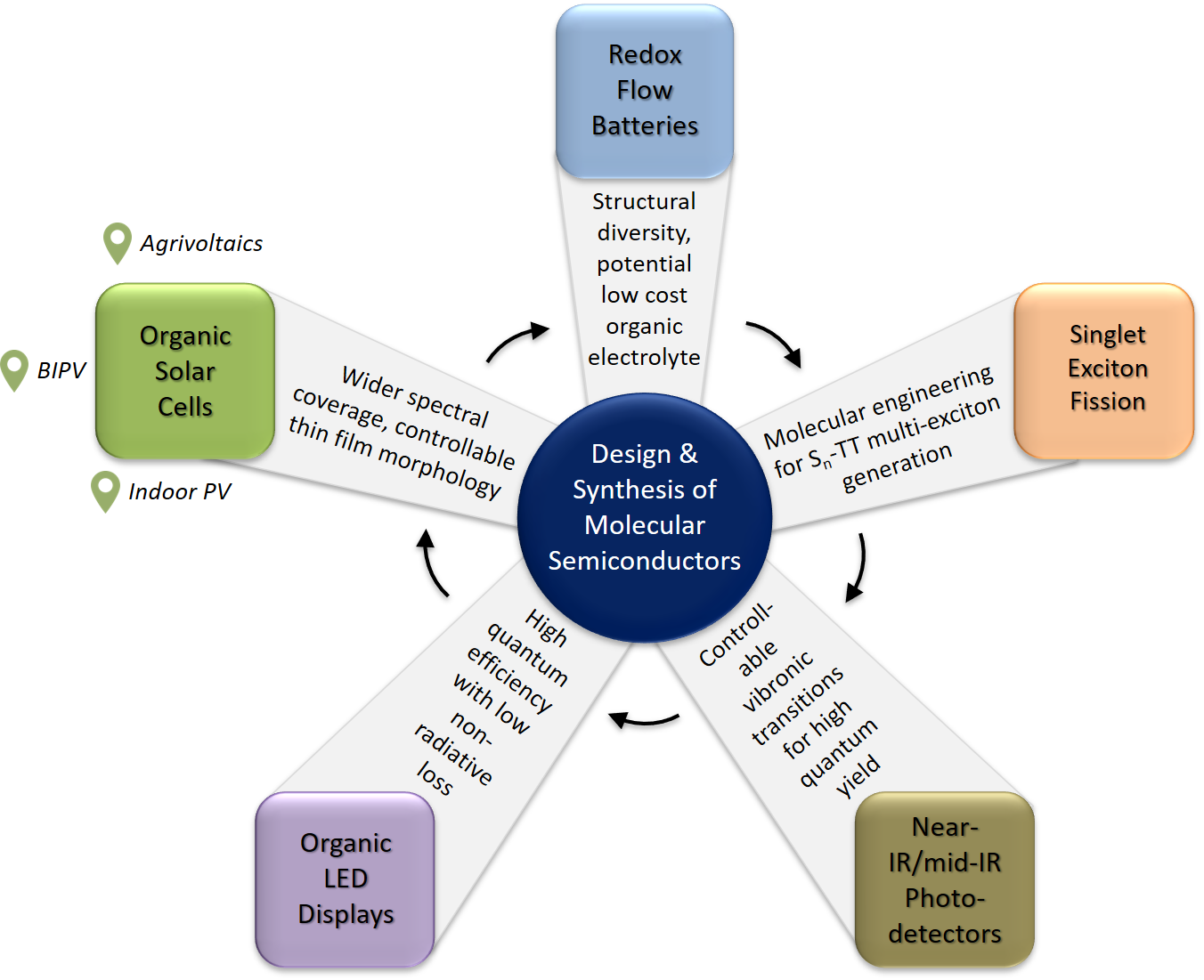
Singlet Fission and Thermally Activated Delayed Fluorescence
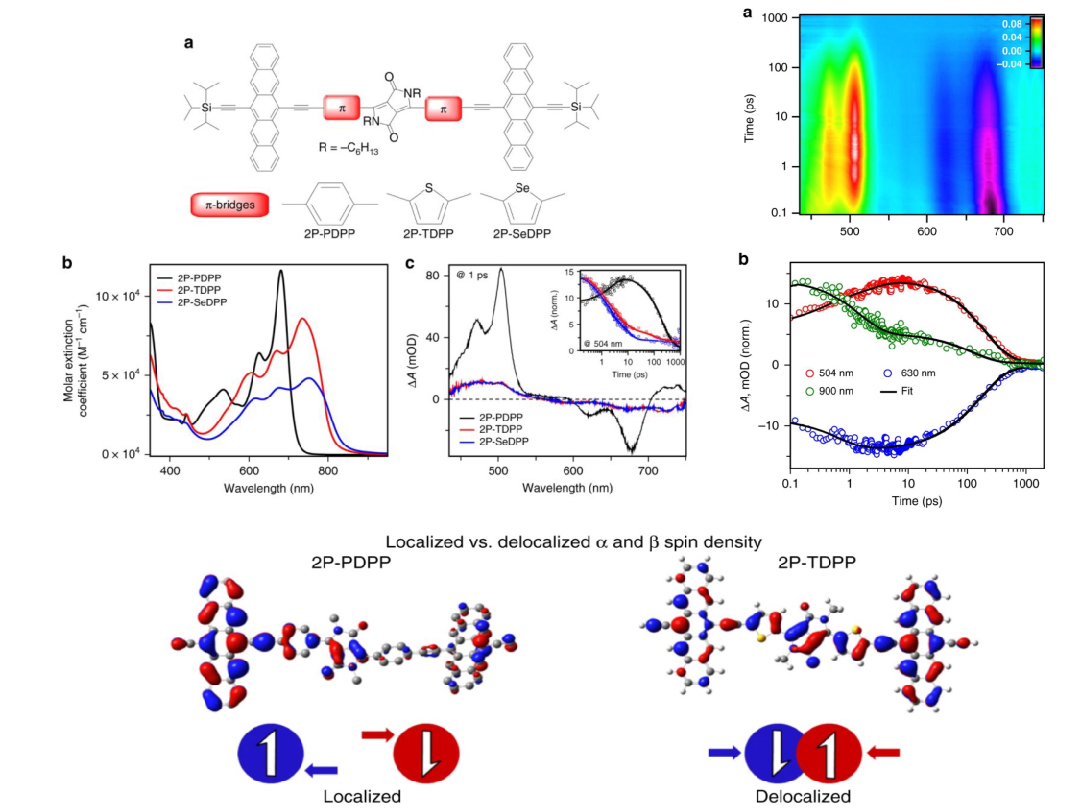
Spin density encodes intramolecular singlet exciton fission in pentacene dimers
In organic chromophores the first excited singlet and the lowest triplet energy gap is very important in determining its physical and optical properties. Whereas a low energy gap makes it suitable for delayed fluorescence, a high enough energy gap where the triplet is near about half the first excited singlet energy makes it favorable for a phenomenon called Singlet Fission. In our group we explore molecular design principles that allow us to modulate this energy gap for various applications in Organic photovoltaics (OLED’s and Solar Cells). We investigate the excited state dynamics with various steady state and time resolved spectroscopic techniques to understand the various recombination processes, exciton dynamics and charge carrier generation for optimised in-house fabrication of organic photovoltaic devices.
Singlet Fission (SF) is a bichromophoric process whereby a singlet exciton is converted to two triplet excitons through an overall spin conserved process. The initially excited chromophore in its singlet state (S1) decays to its lowest triplet simultaneously exciting another coupled chromophore in its ground state to its lowest triplet state. The singlet state must be nearly double the energy of the triplet state for the molecule to undergo efficient SF which inherently limits the abundance of molecules that exhibit SF. Despite the many challenges, its potential in photovoltaics attracted wide attention in understanding this complex photophysical process in an effort to make it a viable alternative. Our group specialises in designing new materials to explore the mechanistic aspects of singlet fission as well as for application is practical devices. With the help of femtosecond transient absorption spectroscopy and other transient spectroscopic techniques we investigate the detailed excited dynamics in a wide range of molecules from small molecules to molecular dimers and oligomers. To learn more about this process we recommend you to look at the following reviews: doi.org/10.1021/cr1002613, doi.org/10.1146/annurev-physchem-040412-110130, doi.org/10.1021/acs.chemrev.8b00572, doi.org/10.1146/annurev-physchem-042018-052435
Presently, we are involved in understanding the role of CT states and spin densities in singlet fission kinetics. Apart from this we are also concentrated on understanding and realising a long ridden problem in singlet fission, harvesting free triplets for practical applications through both molecular design and device fabrications. Recently, we showed that spin density localisation is crucial in dictating singlet fission kinetics in diketopyrrolopyrrole bridged pentacene dimers. We are currently exploring parallel triplet pathways that coexist in molecular aggregates at different timescales. At shorter timescales we observe singlet fission born triplets whereas in longer timescales we see intersystem crossing triplets begin to dominate in these aggregates raising important questions regarding their internal dynamics.
Thermally Activated Delayed Fluorescence is a phenomenon commonly observed in organic chromophores with low singlet-triplet energy gap making thermally assisted reverse intersystem crossing feasible. This results in a delayed fluorescence with a much higher lifetime than normally observed in spontaneous emission. Thermally Activated Delayed Fluorescence (TADF) has known applications in Organic Light Emitting Diodes (OLEDs).
Representative Publications:
- KC Krishnapriya, Palas Roy, Boregowda Puttaraju, Ulrike Salzner, Andrew J Musser, Manish Jain, Jyotishman Dasgupta and Satish Patil, Spin Density Encodes Intramolecular Singlet Exciton Fission in Pentacene Dimers, Nat. Comm. 2019, 10.1038/s41467-018-07736-3.
-
KC Krishnapriya, AJ Musser, S Patil, Molecular design strategies for efficient intramolecular singlet exciton fission, ACS Energy Letters 4 (1), 192-202.
- T Mukhopadhyay, AJ Musser, B Puttaraju, J Dhar, RH Friend, S Patil, Is the chemical strategy for imbuing “polyene” character in diketopyrrolopyrrole-based chromophores sufficient for singlet fission?, The Journal of Physical Chemistry Letters 8 (5), 984-991
Organic Photovoltaics
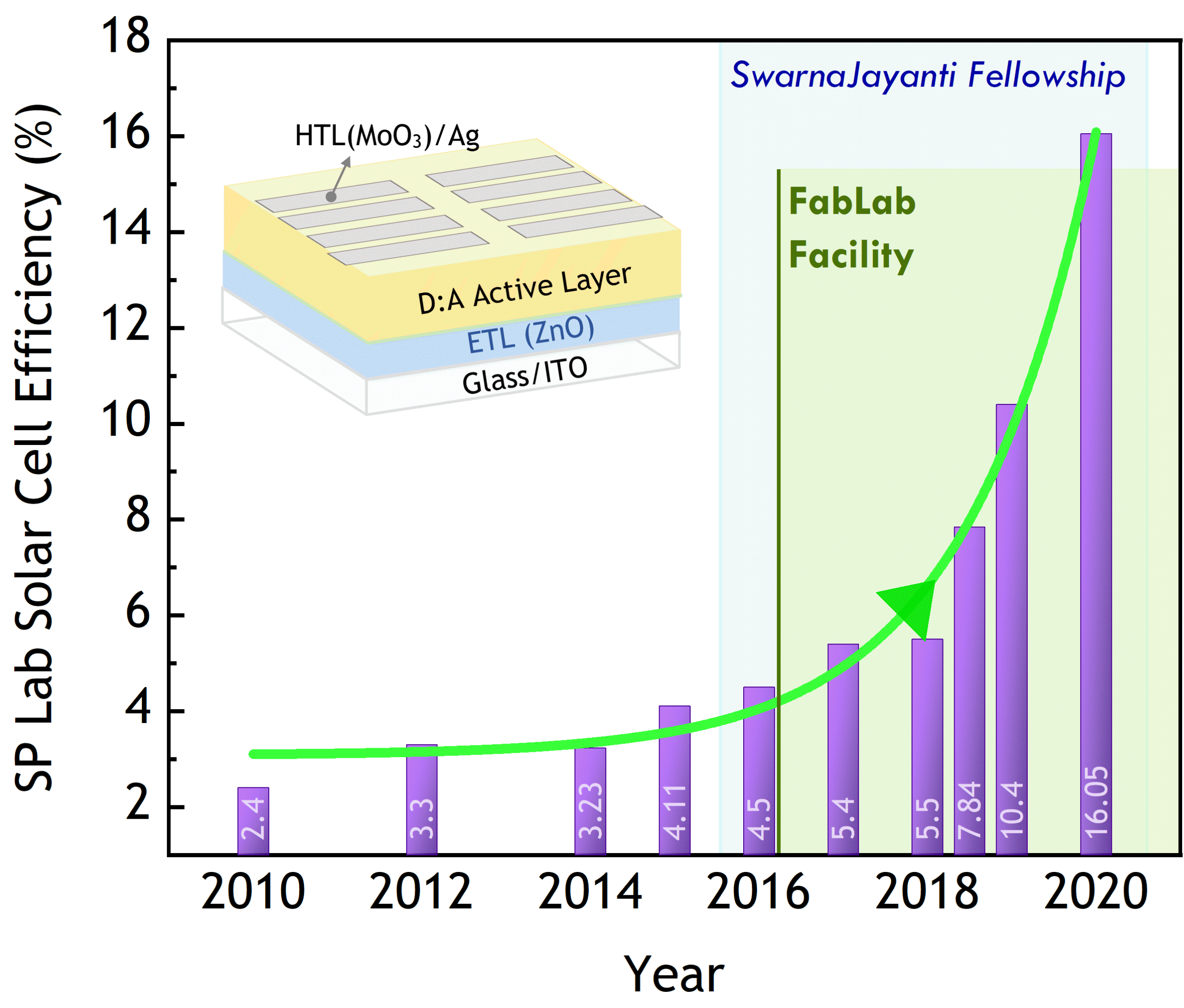
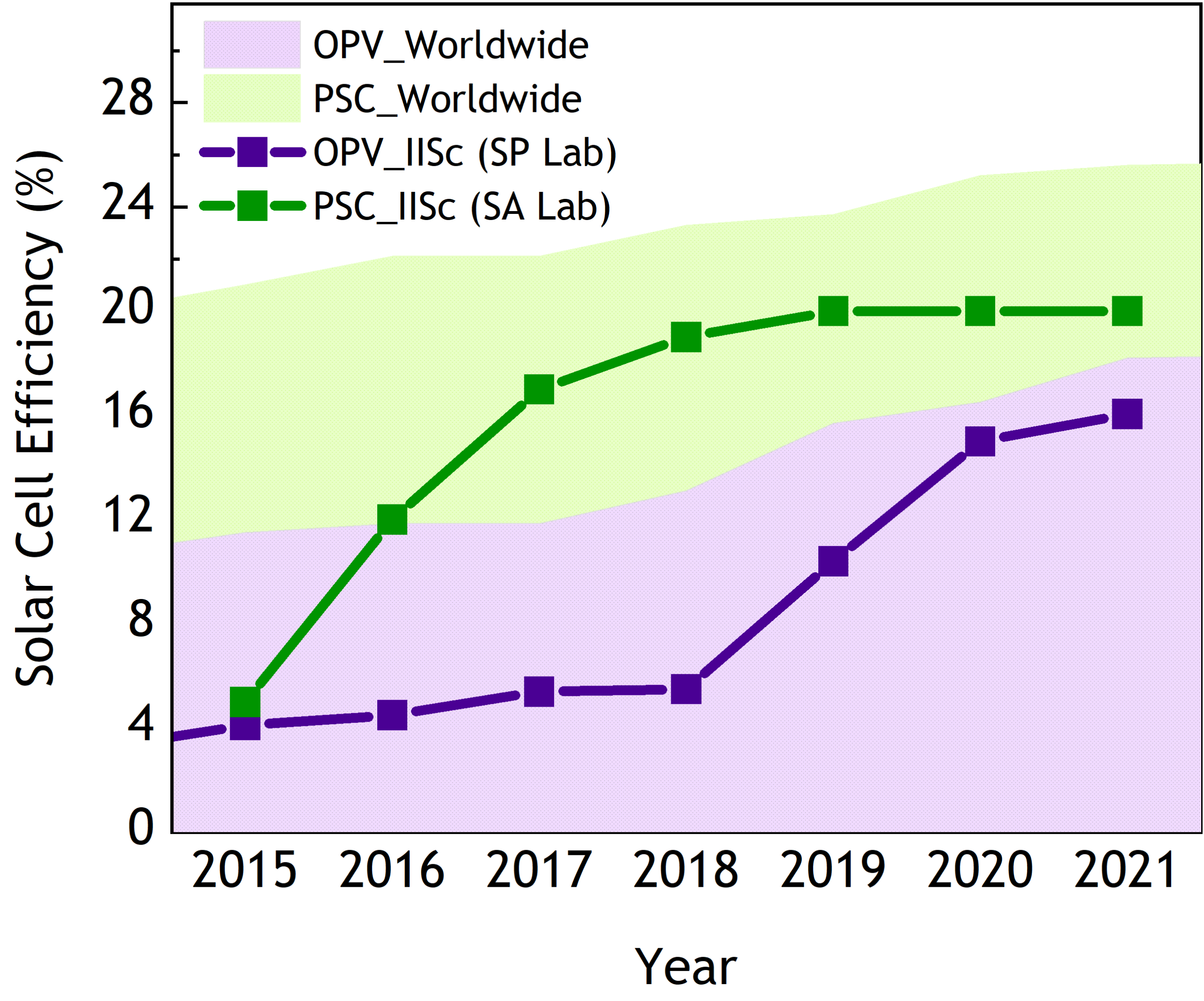
Organic photovoltaics (OPVs) is one of the emerging energy harvesting technologies owing to their low-cost fabrication, semitransparency, flexibility and solution processability among other advantages. In recent years, concerted efforts in developing new organic semiconductors, especially non-fullerene acceptors (NFAs), combined with advancement in device engineering have propelled the power conversion efficiencies (PCEs) >18%. Our research subgroup working in the area of OPVs has three-fold interests.
- Probing the role of charge transfer and resonance energy transfer (RET) in high efficiency blends using steady state and transient spectroscopic techniques.
- In order to push the PCE of the OPVs further, ternary blend systems utilizing novel NFAs are also designed and studied to counter the limited absorption range of organic semiconductors as well as to facilitate exciton dissociation and charge collection.
- Our recent advents into the regime of semi-transparent OPVs aim to better understand design parameters and device physics for building integrated photovoltaic applications.
In addition, our research subgroup focuses in synthesizing new hole and electron transporting materials that can be employed in organic/perovskite solar cells.
Representative Publications:
- Yaping Zang, Suman Ray, E-Dean Fung, Anders Borges, Marc H Garner, Michael L Steigerwald, Gemma C Solomon, Satish Patil and Latha Venkataraman, Resonant Transport in Single Diketopyrrolopyrrole Junctions, J. Am.Chem. Soc. 2018, 140 (41), 13167–13170.
- AA Mohapatra, Y Dong, P Boregowda, A Mohanty, A Sadhanala, X Jiao, Rational Design of Donor–Acceptor Based Semiconducting Copolymers with High Dielectric Constants, The Journal of Physical Chemistry C 125 (12), 6886-6896
- AA Mohapatra, V Tiwari, S Patil, Energy transfer in ternary blend organic solar cells: recent insights and future directions, Energy & Environmental Science 14 (1), 302-319
- C. Kanimozhi, N. Y. Gross, K. W. Chou, A. Amassian, T. D. Anthopoulos and and S.Patil, Diketopyrrolopyrrole-Diketopyrrolopyrrole-based Conjugated Copolymer for High-Mobility Organic Field-Effect Transistors, J. Am. Chem. Soc. 2012, 134, 16532.
- Tushita Mukhopadhyay, Boregowda Puttaraju, Satyaprasad P. Senanayak, Aditya Sadhanala, Richard Friend, Hendrik A. Faber, Thomas D. Anthopoulos, Ulrike Salzner, Andreas Meyer, and Satish Patil*, Air-Stable n-channel Diketopyrrolopyrrole−Diketopyrrolopyrrole Oligomers for High Performance Ambipolar Organic Transistors, ACS Appl. Mater. Interfaces, 2016, 38, 25415–25427
Organic Field-Effect and Electrochemical Transistors
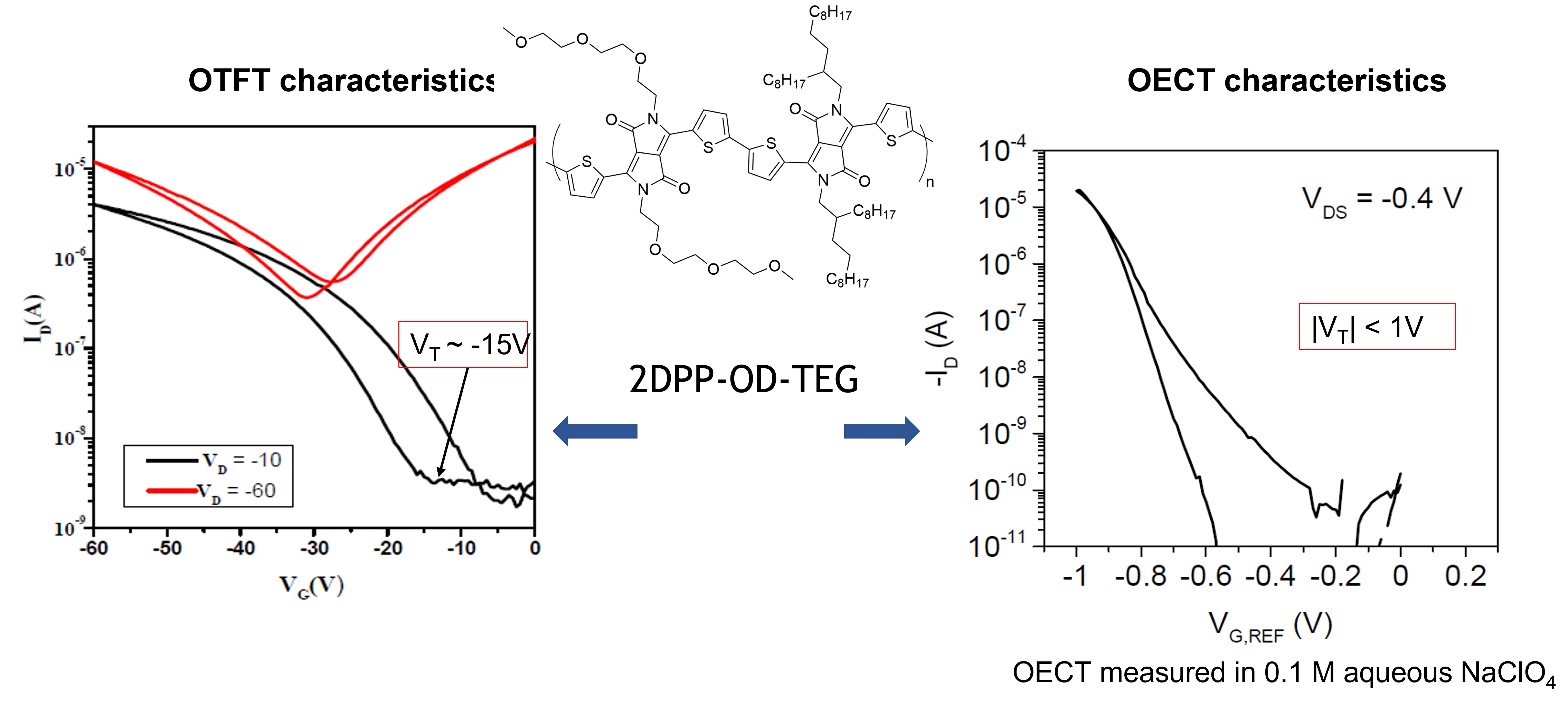
Our group research interests are in the design, synthesis and study of organic-based electronic materials. The rational synthesis of solution processable, air-stable n-type organic semiconductors and the fabrication of high-performance solution-processed n-channel devices with near-IR absorption properties have remained at the top of research priority in the area of organic electronics. The objective of our research is an attempt to answer this core question and has significantly impacted the field of organic electronics. In pursuit of better n-type materials, our group has developed novel series of diketopyrrolopyrrole (DPP)-based alternating copolymers. Surprisingly, the simple molecular engineering has led to a big improvement in electron mobility (~3 cm2V-1S-1) of this class of polymers in organic field-effect transistors. The continuous increase of electron mobility by rational design of DPP-DPP copolymers relates to a preferential face-on orientation and improved p-p stacking of the polymer backbones. These significant results appeared in J. Am. Chem. Soc. 2012, 134, 16532-16535. Development of these DPP-DPP copolymers has opened up a new family of n-type molecular semiconductors. These materials have the potential to find applications in all-polymer solar cells, polymer-based inverters and near-IR light-emitting transistors.
Furthermore, our work demonstrates the effectiveness of molecular design to overcome the limitations of traps and structural disorder in semiconducting polymers. The polymer synthesized in our group is a completely new type that acts more like conventional inorganic semiconductors with a band-like transport (Phy. Rev. B, 2015, 91, 115302). Observation of band-like transport could lead to a new generation of disorder-free conjugated polymers. This work overcomes the transport properties of semiconducting polymers, limited by pervasive conformational and energetic disorder. The dielectric constant enhancement of organic materials is a viable route to enhance the efficiency of organic photovoltaic devices. This is mainly due to the low dielectric constant of current OPV materials where electrons and holes cannot overcome their binding energy, which exceeds the thermal energy at room temperature. To date, only very few attempts towards increasing the dielectric constant of organic semiconductors have been published. Taking this fact into account, our group has introduced the strategy for enhancing the dielectric constant of π-conjugated polymers without altering the charge-carrier mobility (Adv. Funct. Mat., 2015, 25, 150-157). In brief, the applied molecular design of our work is an effective method towards tailoring the properties of organic semiconductors that can provide a platform to investigate various physical phenomena restricted by disorder in semiconducting polymers.
Representative Publications:
- Yaping Zang, Suman Ray, E-Dean Fung, Anders Borges, Marc H Garner, Michael L Steigerwald, Gemma C Solomon, Satish Patil and Latha Venkataraman, Resonant Transport in Single Diketopyrrolopyrrole Junctions, J. Am.Chem. Soc. 2018, 140 (41), 13167–13170.
- AA Mohapatra, Y Dong, P Boregowda, A Mohanty, A Sadhanala, X Jiao, Rational Design of Donor–Acceptor Based Semiconducting Copolymers with High Dielectric Constants, The Journal of Physical Chemistry C 125 (12), 6886-6896
Electrochemical Energy Storage Devices

Schematic of an all-organic redox flow battery with Unisol blue and TDPP-Hex-CN4 as positive and negative electrolyte, respectively.
All Organic Non-Aqueous Redox Flow Battery
Organic redox flow batteries (ORFBs) are attractive candidates for large-scale energy storage devices owing to its advantages in terms of cost, structural tunability, molecular diversity, and natural abundance. The operating cell voltages in aqueous redox flow batteries are limited to 1.23 V as beyond this voltage water electrolysis will be taking place leading to oxygen and hydrogen evolution. By contrast non-aqueous redox flow batteries can theoretically deliver the cell voltage up to 4V while utilizing stable organic solvents (e.g. acetonitrile, propylene carbonate and dimethoxyethane etc.) and suitable organic redox active couples. Apart from limited solubility, lack of high-performance membranes and low electrolyte conductivity, stability of constituent electrolyte materials is one of the major issues impeding the development of non-aqueous redox flow batteries. Both redox-active molecules need to be stable during charge-discharge cycling operations while being repeatedly oxidized and reduced with negligible degradation in performance. In this regard, stable anolytes are rare, primarily because of the low stability in the presence of oxygen and moisture. Our group is investigating the suitability of Diketopyrrolopyrrole derivatives as stable anolytes for all organic non aqueous redox flow battery.
Redox Flow Batteries
Redox flow batteries (RFBs) offer an opportunity to make renewable energy storage more affordable and could accelerate prospects for utility-scale development of solar/wind energy storage. RFBs can be almost instantly recharged by replacing the liquid electrolyte. RFBs can be cycled more often and can lend themselves to 100% depth-of-discharge with no negative effects on performance unlike lead-acid and lithium-ion batteries with depths-of-discharge of 60 and 80%, respectively. RFBs can also last for decades (up to 25 years) before being replaced, making them promising for large utility applications, micro-grids and off-grid projects. Our group is currently working on both aqueous and non-aqueous redox flow batteries.
Soluble Lead Redox Flow Battery
Soluble lead redox flow batteries (SLRFBs) present several advantages over competing flow battery systems. SLRFBs make use of variable oxidation states of lead. In its simplest form, Pb2+-ions are dissolved in a less toxic and cost-effective aqueous methanesulfonic acid medium as electrolyte that flows through the cells without expensive separators. There are, of course, challenges to surmount such as those related to phase changes at both the positive and negative electrodes. The major challenges are formation of Pb dendrites, PbO2 sludge, O2 evolution and shunt current effect in stacks. Our work is based on addressing each of these problems systematically by studying the effect of binary additives in the electrolyte and achieving extended cycle life of SLRFB. To bring the concepts into context, we have designed, developed and demonstrated the first-ever fully functional SLRFB stack (12 V / 250 Wh) comprising 8-cells with 500 cm2 electrode active area. Developing a stack has its own challenges, for example, occurrence of shunt current. We have studied the origin of shunt current and proposed a novel method to measure and minimize its effect on SLRFB stack. We are currently working towards scaling up the SLRFB technology to demonstrate 1 kWh stack. The studies in our group are primarily directed to propel SLRFBs from laboratory scale to a functional system by addressing key issues of scaling-up materials, fabrication and engineering.
Recent Publications
- Rathod, S.; Jaiswal, N.; Ravikumar, M. K.; Patil, S.; Shukla, A. Effect of Binary Additives on Performance of the Undivided Soluble-Lead-Redox-Flow Battery. Electrochimica Acta 2021, 365, 137361.
- Sharma, S.; Rathod, S.; Yadav, S.P.; Chakraborty, A.; Shukla, A.; Aetukuri, N.; Patil, S. Electrochemical Evaluation of Diketopyrrolopyrrole Derivatives for Non-aqueous Redox Flow Battery. Chemistry – A European Journal, 2021, manuscript ID chem. 202003279, (Accepted)
- Rathod, S.; Ravikumar, M. K.; Jaiswal, N.; Patil, S.; Shukla, A. Extending cycle-life of the soluble-lead-redox-flow-battery with an auxiliary gas-diffusion electrode: A Proof-of-Concept study. Ionics, 2021, manuscript ID IONICS-2020-0813, (Accepted)
- Ravikumar, M. K.; Rathod, S.; Jaiswal, N.; Patil, S.; Shukla, A. The Renaissance in Redox Flow Batteries. Journal of Solid State Electrochemistry 2016, 21, 2467-2488.
